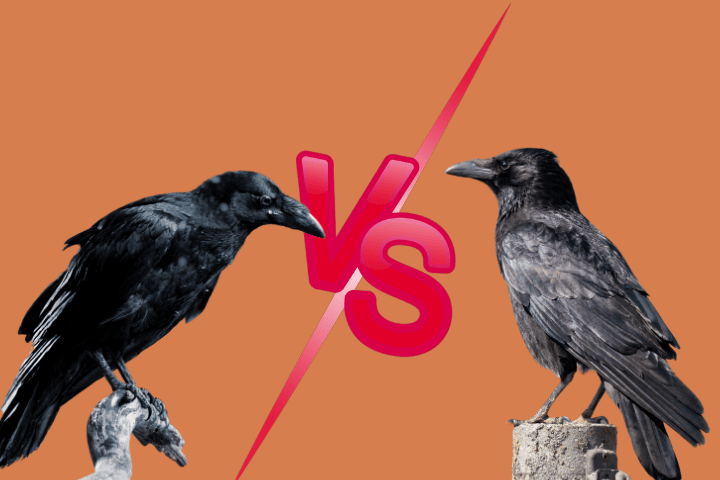In the enigmatic world of corvids, ravens and crows reign as some of the most intelligent and adaptable birds. While their striking black plumage and clever behaviors often lead to confusion between the two, ravens and crows are distinct in many ways. In this article, we’ll explore the key differences between these two fascinating birds, examining their physical characteristics, behaviors, and cultural significance.

Raven Vs Crow: Size and Build
One of the most noticeable differences between ravens and crows is their size. Ravens are significantly larger, with a more robust build. A common raven can reach lengths of 24 to 27 inches, with a wingspan stretching up to 54 inches. Crows, in comparison, are more modest in size, typically measuring 16 to 21 inches long with a wingspan of about 33 to 39 inches. The raven’s larger size not only makes it more imposing but also affects its flight dynamics, giving it a more powerful and soaring flight compared to the crow’s more agile and quicker movements.
Plumage and Appearance
Both ravens and crows are cloaked in black feathers, but subtle differences in their appearance can help distinguish them. Ravens have a slightly iridescent quality to their feathers, with shades of blue or purple visible under direct sunlight. Their throat feathers are also more pronounced, often appearing shaggy. Crows, on the other hand, have a more uniform black coloration with a smoother appearance, lacking the raven’s iridescent sheen and distinctive throat feathers.
Tail Shape and Flight Patterns
Tail shape is another characteristic that sets these two birds apart. Ravens possess a wedge-shaped tail that becomes particularly noticeable in flight, creating a pointed silhouette. This contrasts with the crow’s fan-shaped tail, which spreads out evenly and appears more rounded when the bird is in the air. Additionally, ravens are known for their acrobatic and playful flight patterns, often engaging in aerial stunts such as barrel rolls. Crows, while capable of swift and agile flight, tend to have a more direct and purposeful flight style.
Beak and Facial Features
Ravens have a more pronounced and powerful beak compared to crows. Their beaks are larger, with a more curved and heavier structure, which is well-suited for tearing into tough materials like carrion. This feature gives ravens a somewhat more formidable appearance. Crows, by contrast, have a smaller and straighter beak, which is adept at handling a variety of foods, including seeds, insects, and small animals. Additionally, ravens often display more prominent bristles around their beaks, further distinguishing their facial profile from that of crows.
Vocalizations and Communication
The vocal abilities of ravens and crows are both remarkable, but they differ in sound and complexity. Ravens produce a deep, resonant croak that is often described as a “gronk” or “krronk,” and they are known for their ability to mimic a wide range of sounds, including human speech. Their calls are more varied and complex, often reflecting their sophisticated social interactions. Crows, on the other hand, are famous for their sharp, repetitive “caw” sounds, which are higher-pitched and more straightforward. Though less varied than raven calls, crow vocalizations are equally effective in communication, especially within their highly social groups.
Social Structure and Behavior
Ravens and crows exhibit different social behaviors that reflect their respective lifestyles. Ravens are more solitary by nature, often seen alone or in pairs, particularly during breeding season. They are also known for their strong territorial instincts. Crows, in contrast, are highly social and are frequently observed in large groups or “murders.” These groups are especially common in urban areas, where crows have adapted to living closely with humans. Their social structure is complex, with strong family ties and cooperative behaviors that are crucial to their survival.
Intelligence and Problem-Solving
Both ravens and crows are celebrated for their intelligence, but each species excels in different areas. Ravens are known for their problem-solving abilities and have been observed using tools to obtain food, such as dropping nuts onto roads for cars to crack open. They also exhibit playful behaviors, often engaging in games or using objects in their environment creatively. Crows, while also adept problem-solvers, are particularly known for their memory and learning capabilities. They have been shown to recognize human faces, remember those who have treated them well or poorly, and even pass this knowledge on to other crows.
Cultural Symbolism
Ravens and crows hold significant places in various cultures and mythologies. Ravens are often associated with mystery, transformation, and prophecy, appearing in legends as symbols of change or as messengers of the gods. In Norse mythology, Odin’s ravens, Huginn and Muninn, are said to fly across the world to bring back news to the god. Crows, on the other hand, are frequently depicted as clever tricksters or symbols of adaptability. In many cultures, crows are seen as omens, often linked to both life and death, reflecting their dual nature as scavengers and intelligent survivors.
Conclusion
Although ravens and crows may seem similar at a glance, a closer look reveals a world of difference between them. From their size and vocalizations to their social behaviors and cultural meanings, each bird has unique traits that make them fascinating subjects of study. Whether you’re a seasoned birdwatcher or simply curious about these remarkable creatures, understanding the distinctions between ravens and crows offers a deeper appreciation of these intelligent and enigmatic birds.
